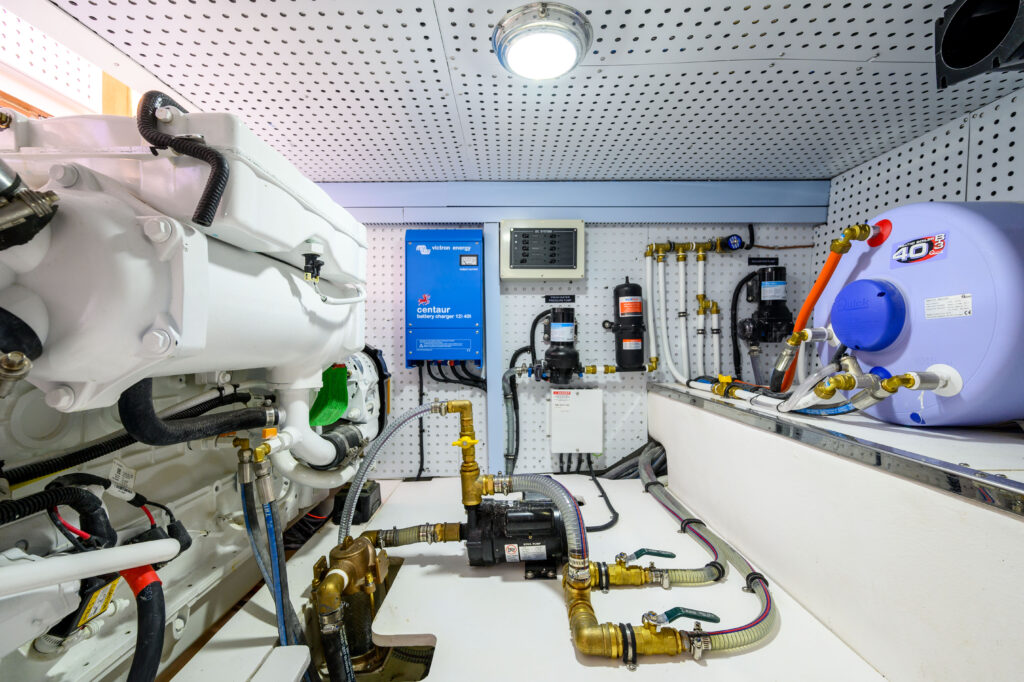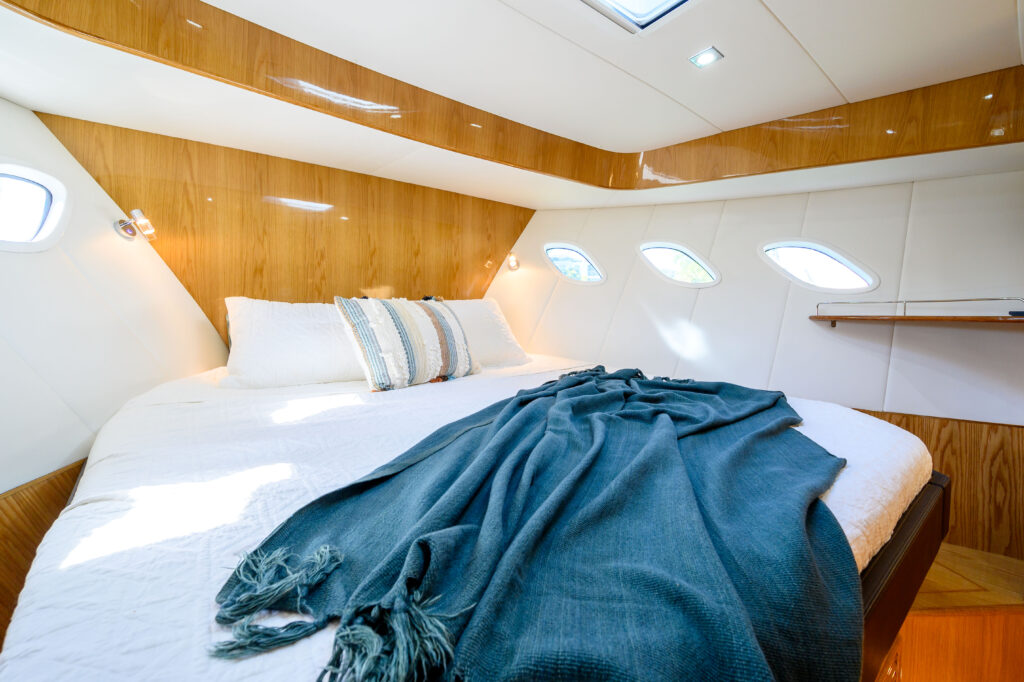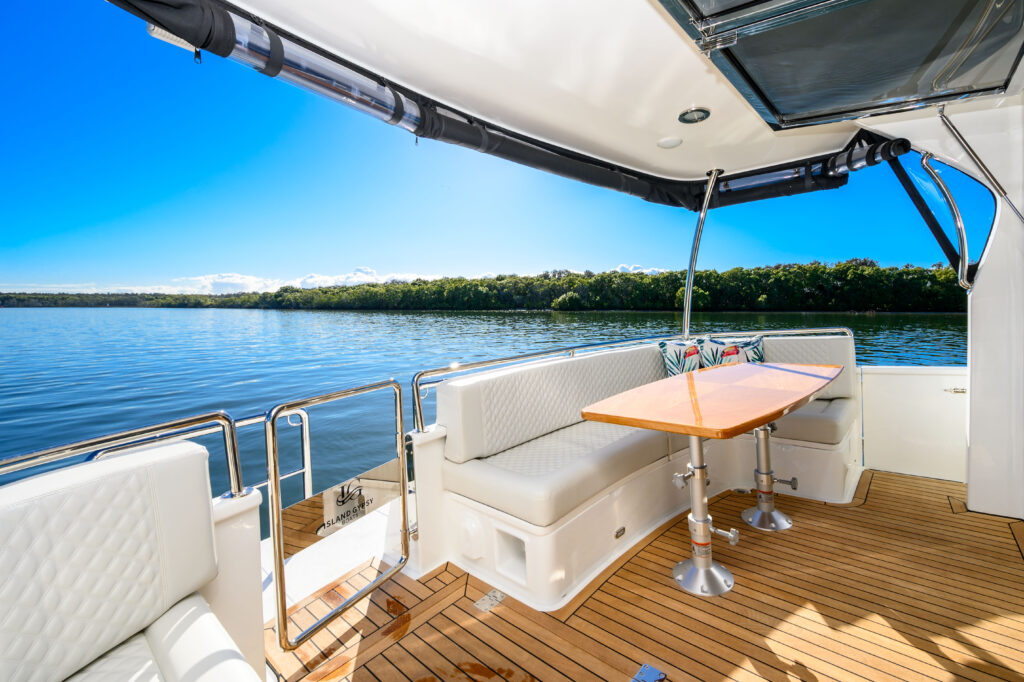ADVENTURE AWAITS THOSE WITH GYPSY SOULS
I reviewed the Island Gypsy 50 WB earlier this year, and more recently the 40 WB, so I took the time to read what makes this company standout from the others in the semi displacement cruising market.
As a writer it is always a worry that you might repeat yourself or run out of superlatives to describe a vessel in what sometimes can be a vanilla marketplace. But I shouldn’t have given it a second thought when jumping aboard the Island Gypsy 40 wide body. I was shown around the newest version by director, veteran boatbuilder and importer and allround great bloke of Island Gypsy Boats, Brett Flanagan. And the one thing you come to realise about Brett is that he is an ideas man, a sort of a “Gyro Gearloose” of the boatbuilding trade. It seems he never stops refining and whittling ideas out of his first initial brainchild.
HULL
The first of the innovations is found around the hull. The bow chine starts aft, eight or so centimetres above the water and finishes on the stem around 30 centimetres above the water. It is quite a chunky chine and so I asked Brett how it works. “When at rest trying to get to sleep, I hate the sound of the water tapping the traditional semi-submerged chines. But a chine is necessary to clear the water from the bow and create a dry boat, so this does both jobs, leaving just the hull in the water while at rest and works as a great splash guard while underway.” Further astern on the hull five distinctive groves run midway up the hull, from just forward of the rear of the chine to almost all the way down to the stern. These lines are “purely aesthetic” according to Brett, and are simply a doth of the cap to the clinker heritage of this style of cruiser.
SWIM PLATFORM
When climbing aboard the 40 from the swim platform, you could almost be tricked into thinking you were climbing aboard a sports cruiser-style vessel. There is no mean duckboard and hard transom to negotiate. You are met with a wide Portofino stern, which for the uninitiated is simply a swim area that is included in the hull rather than bolted on.
The juxtaposition of this hull and stern make you want to hop off and take another look from the jetty. And yes, it is true – you have the classic lines of a semi-displacement vessel – a salute to its nautical past and the sporty rear end of a sports cruiser. You now see why when dealing with Brett I should always have confidence in my kit of superlatives as there is always something different he is cooking up.

COCKPIT
Once aboard through the starboard gate you’re into a nice wide cockpit, complete with aft waffled transom settee complemented with an expensive looking, shiny golden, hewn slab of tabletop wood. It kicks off our journey into the rest of the sparkling woodwork panels that make up the interior of the boat and end with a finale all the way downstairs as the bedhead in the master cabin.
But back to the cockpit, where underfoot in the lazarette is 1000 litres of fuel capacity and, nicely tipping the scales, the other way is the 700 litres of fresh water which has a home forward in the master’s cabin. The cockpit, swim platform and saloon are three entirely separate rooms while zipped up for the weather with camper covers creating the cockpit space and a wall created by a lift-up glass panel and a half door which ensure the saloon remains snug. But the natural state of this boat is most definitely opened up, the camper covers off and the tropical breezes pumping through.
GALLEY AND SALOON
The aforementioned lift-up glass panel pins up to the ceiling of the cockpit outwards from the saloon and galley. If there was one small thing that I could fret about (and talk about your first world problems), it would be the height as I wander through. The metal edge of the glass panel sits around 190 centimetres from the saloon floor and I am 187 centimetres in height. Combine that with an eager and distracted step up I came close to touching the top of my noggin on the frame, but I didn’t. Once inside the saloon the headroom increases by an extra five plus centimetres, and you feel that sense of volume that is synonymous with the brand. The galley sports the same sparkling timber finish that ties the look of the boat together.
With the benchtops there is a reflection of the soft furnishings, a sort of a stark white with the cupboards fashionably underlit. And with a couple of well-placed recessed over bench lights to check on the state of the steak, this all blends beautifully with the hood lining, aft and saloon dining settees.

PILOT STATION
The helm area located on the starboard side has a slight step up to define it and below there are the usual number of dials tapped into the engine is at helm level. A single centred multi-screen is just below eye level to handle your navigation needs. And there’s plenty of room for extra screens for folks who like a more complicated set-up – for me the simplicity of the layout is bang on.
There is plenty of room to scoot up and down along the helm station between the luxe double, white, waffle-branded helm seat and the wheel. And a pop out dogged full-sized door to get you out on the deck quick sticks. The door took me a minute to work out with an old-fashioned chrome handle and a chrome pin-style lock button – the sort you would find on an old Cadillac, pure simplicity and classic aesthetics.

ENGINE ROOM
The saloon floor has several hatches, each accessing bits of the engine. For instance, you can have a quick look by pulling up the forward hatch or remove a couple more for a full blown “WTF” look. The engine has oodles of room either side, one of the advantages of a single screw situation in a large vessel. It has the typical Island Gypsy blue underlighting on the white gel coat to pick up any leaks or spillages at a glance. As usual I didn’t spend too much time down there to try to describe things I don’t know a lot about, suffice to say it was a large, clean and uncomplicated space.

ACCOMMODATIONS
The forward master cabin has plenty of light provided by a hatch and a couple of windows either side and the bed is a surprising size. I am not usually drawn to an island bed, but this thing is king-sized and easily accommodated my length. The up and under bunks further back towards the saloon on the starboard side make for great guest quarters with the bottom looking closer to a double. Opposite is the large bathroom with full sized shower and separate toilet. There is also a lot of bench space obviously catering for stay aboard situations.

OUTSIDE
The walk around side decks or gunwales are hugely practical, there is no balancing act getting yourself around the boat with plenty of hip space and rails to keep you in. And the forward deck is a bit of a blank canvas – a large space left empty so an owner could put sun pads on it or a simple deck chair to throw a line over.
HEIGHT
This vessel was obviously designed for cruising situations and getting up into the river systems and harbours. This is easily achieved with the drop-down, traditional looking radar pole, low height and flat roof all extending cruising right up into the middle of Australian cities under the low bridges.

LINEAGE
Island Gypsy Yachts traces its roots back to over 130 years when Halvorsen Boats were launched in Norway in 1887 by Halvor Andersen. His son Lars joined the family business and a few years later relocated to Sydney with his family. There the Halvorsen name became synonymous with quality and style in the boat building industry. Lars died in 1936 and the business passed to his eldest son, Harold, who continued to design pleasure, commercial and military vessels. He was awarded the Order of Australia Medal in 2000 in recognition of his contribution to the war effort. During the 1970s, Harold’s son Harvey became the new designer for the business and in 1975 he started a venture between his family business and marine heavyweight Joseph Kong. The new project was to design, build and market a brand-new range of pleasure boats all over the world.
Harvey started with a new 30-foot design, and while designing the vessel he began to brainstorm names for the brand. He wanted to sell a lifestyle, so began gaining inspiration from thoughts of cruising the Great Barrier Reef and other exotic lands. He didn’t want to use the Halvorsen name in case the range was ever sold, and seemingly out of nowhere came up with the name “Island Gypsy”.
However, years later he found out that in 1948 the family business had actually built a large boat for the tourist market with the name “Island Gypsy”, to be used on the reef. At the time he was just nine, so the name had clearly stayed with him subconsciously.
FROM DIRECTOR BRETT FLANAGAN
“Ninety per cent have been fitted with Cummins 355 Hp and the other engines that we have fitted are the fantastic Nanni diesels. For the uninitiated, Nanni diesel engines are a Toyota-based marine diesel engine developed from the original automotive blocks of Toyota. These engines range from 200 to 370 Hp and are designed for powerboats, sports boats, fishing vessels and fast cruisers. Both of those marine engine companies have been fantastic to deal with. Although the boat does lend itself to those slower revving engines with torque. The hull is semi displacement and good for 15 knots with it popping to the plane at around 12 knots. All the 40s have been built with underwater exhaust, which make for a much quieter and less fumy cruise.”
THE FUTURE
“I am building hull number 21 at the moment, after operating for two and a half years and can still get a delivery in before Christmas. With my main clients being mainly Queensland based, I have a line of stock-boat orders in different stages of build and varying sizes. So, a potential owner doesn’t have to wait too long and can put their mark on the vessel, picking out trims, woodwork and even engines, although in saying that I have future proofed a lot of the foreseeable changes that a client might want to make instead of having to do it post factory. For instance, if a buyer wanted to run solar on the roof, we have already run the wiring in the hood lining, so tradies don’t have to rip into it. And if the buyer wants a bigger fridge or another fridge/freezer, next to the standard offering of the 140-litre under bench model, I have put in the extra plumbing and wiring required and you only have to remove the drawers and pop in the bigger model or extra appliance.”
SUMMARY
The Island Gypsy 40 Wide Body may be the smaller of the Island Gypsy offerings in terms of her size, but to find a cruiser with this much useability and liveability for under 900 K is going to be a bit of a stretch. Especially when you consider it comes as a kind of a “hamburger with the lot” with its delivery inclusions incorporating navigation equipment, auto pilot, bow and stern thrusters, generator, air conditioning, right down to the stainless steel chain and anchor. Therefore, she represents fantastic value and economic long-term cruising with classic good looks.
“Embrace the magic of the Gypsy life!”
SPECIFICATIONS
Make and Model IG40WB
Launch Year 2024
Builder Island Gypsy
LOA 12.90 metres
Beam 3.96 metres
Fuel Capacity 1000L
Water Capacity 720L
Engine Make Cummins
Fuel Type Diesel
Air Conditioning 16000 BTU in saloon, 12000 in cabins
Inverter 3000 W
Charting System Raymarine
PERFORMANCE DATA
RPM KNOTS L/h
1600 8 12
2000 12 22.8
2500 14 41.9
3000 15 73.5



